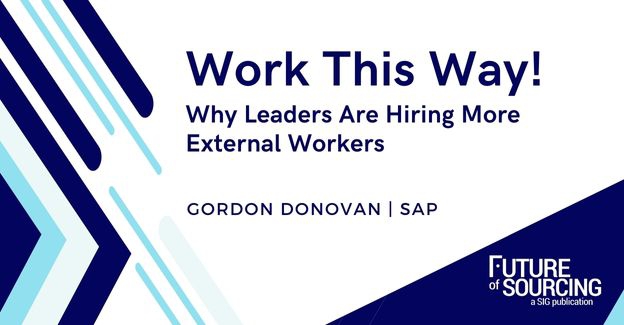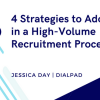Work This Way! Why Leaders Are Hiring More External Workers
"Among the advantages of a staffing strategy that includes external workers is the ability to react quickly to changing business conditions, and to access highly skilled people at lower overall costs," says Gordon Donovan, Director of Market Research for Procurement and External Workforce for SAP. Gordon shares insight into an Economist Impact Survey sponsored by SAP, and the shift to using external workforces amid disrupted supply chains, rising costs, growing uncertainty, and trends.
In a recent Economist Impact survey sponsored by SAP, half of the business leaders said they plan to increase their use of external workers in the next 12 months. While this represents a significant increase, the leaders’ reasons for doing this might surprise you.
SAP started investigating these and other questions earlier this year when we engaged Economist Impact to conduct a global survey of C-level executives across various organizational functions. Respondents included 430 executives comprised of Chief Financial Officers (CFOs), Chief Operations Officers (COOs), Chief Procurement Officers (CPOs), and Chief Supply Chain Officers (CSCOs). Our goal was to learn how businesses and industries are transforming the procurement function amid disrupted supply chains, rising costs, growing uncertainty, and trends that are driving a new future for procurement.
A new Economist Impact paper, Chain reactions: building value in procurement through digitalization, and a specialist mini paper on the external workforce, use survey data to provide insights into the evolution of the workforce, and an inside view of how the procurement function is evolving to help address this evolution.
Executives discuss the changing role of procurement.
After Economist Impact released its paper, a select group of executives convened in a roundtable discussion to share their thoughts on labor shortages, the rise of the external workforce, and the issues that are both solved and caused by these.
The roundtable was convened under the Chatham House Rule, so I can’t reveal who was there or specifically what they said. However, I can tell you that the key themes that emerged were:
• Labor shortages and their impacts
• Risks and solutions
• Strategic implications for procurement and supply chain leaders
Labor shortages and their impacts.
As I mentioned earlier, the Economist Impact briefing paper reported that half of the survey respondents planned to increase their use of external workers over the next 12 months. Based on their own experiences, the roundtable panel cited a shortage of labor as one significant driver for this increase.
But what about the pandemic?
While the pandemic has accelerated labor shortages, the panel agreed it isn’t the cause of labor shortages. Instead, skilled labor is simply in higher demand, and if the skill sets needed are not available internally, it is easier to “buy” the skills than to “make” them. As an example, members of the panel said that individuals with “professional services” skills are challenging to recruit. Therefore, they are looking to external or contingent workers to fill the skills gaps.
The changing nature of work.
Roundtable participants also noted that workers want to be more flexible in how and where they work, which is also contributing to a shortage of available workers. The convergence of digital and physical work is driving this change.
So, what to do?
Clearly, participants in the roundtable recognized the increased use of external workers as a key solution to labor shortages. But what are the risks, and where are the opportunities?
The risks.
The roundtable identified the management of external workers as a key risk. Many participants said they are reaching out to their providers to understand how they are managing their workers. Unless managed effectively, they feared they might lose visibility into delivery teams. This is further complicated by the geographies where work is performed.
Culture and brand impacts were crucial to manage and understand. However, the roundtable also stated that the best organizations don’t differentiate between external and internal talent. Members of the roundtable also expressed concern about risks associated with access to data and confidentiality issues.
The opportunities.
Among the advantages of a staffing strategy that includes external workers is the ability to react quickly to changing business conditions, and to access highly skilled people at lower overall costs (by using them for a shorter period).
This makes the budgeting process easier to manage and encourages many more organizations to buy an outcome rather than solely focus on filling a seat.
Also, from a cost management perspective, the use of temporary workers makes it easier to manage the massive wage rate fluctuations we are experiencing today in the “fully employed model.” Temporary workers offer greater flexibility on budgets, as well as the ability to take a longer-term view on fixed costs.
Talent sourcing is going global.
The pandemic proved that remote work was productive, not just for the employed but also for the external workforce. Many participants in the roundtable stated that this new reality had stimulated a change in internal strategy discussions.
Implications for procurement.
It’s clear that one of the biggest changes in the way procurement operates is because of organizations’ increased reliance on the external workforce. That’s because procuring external workers involves different processes than hiring full-time employees.
Procurement understands these processes. Therefore, it needs to work closely with the human resources function to ensure the business contracts the right temporary workers with the right skills.
Additionally, the work-from-anywhere strategy that some organizations are now pursuing has broader impacts on how to pull together an overall operating model and rhythm. Procurement functions will need to adjust to them.
Region:







